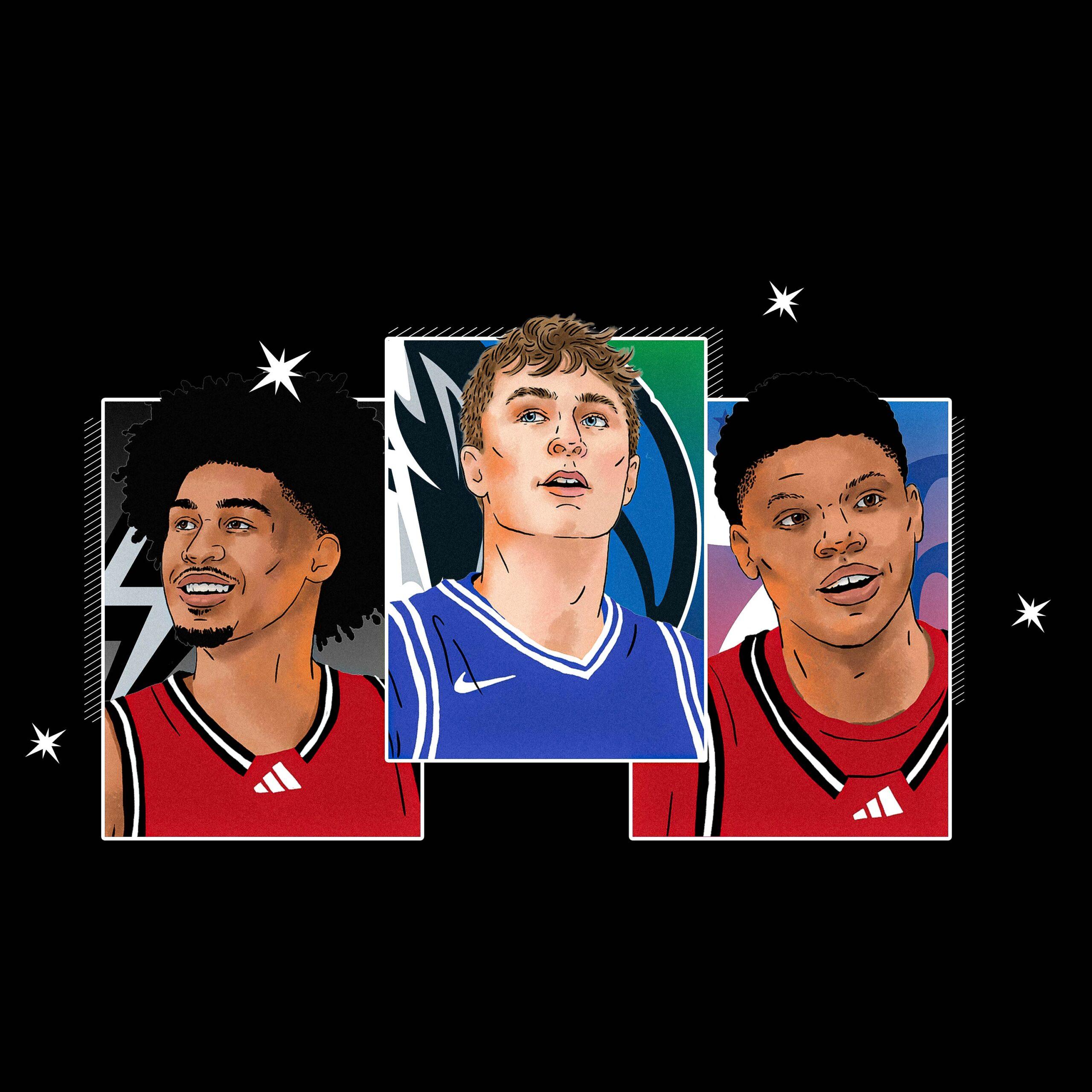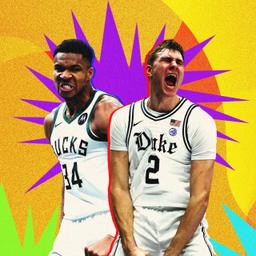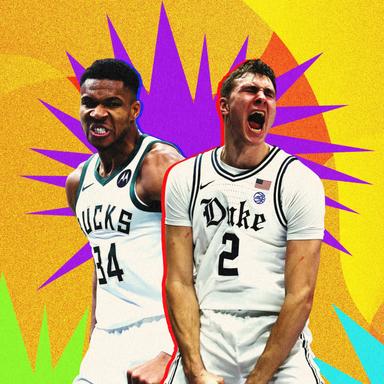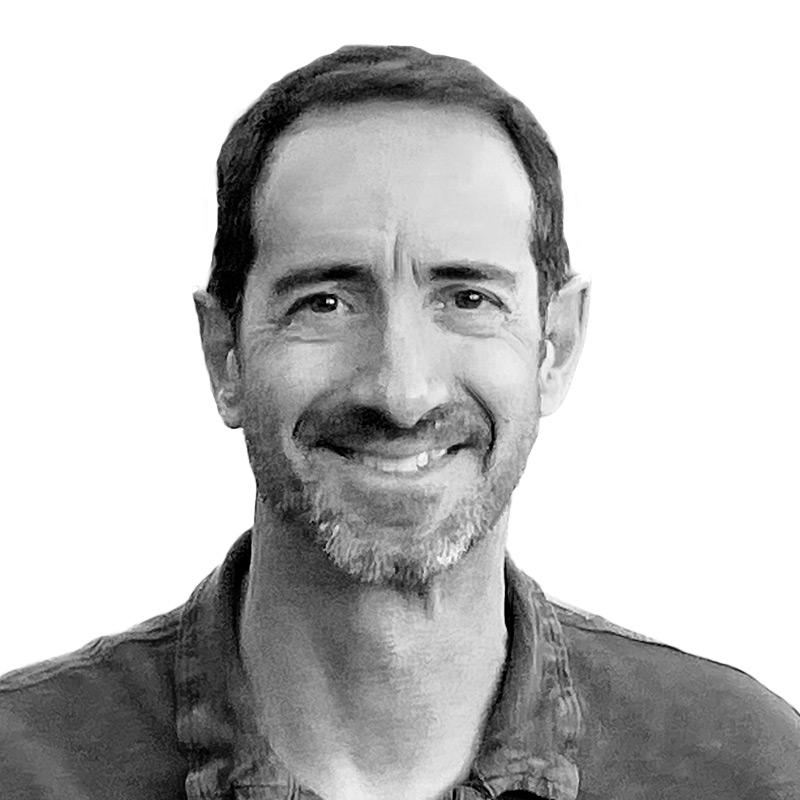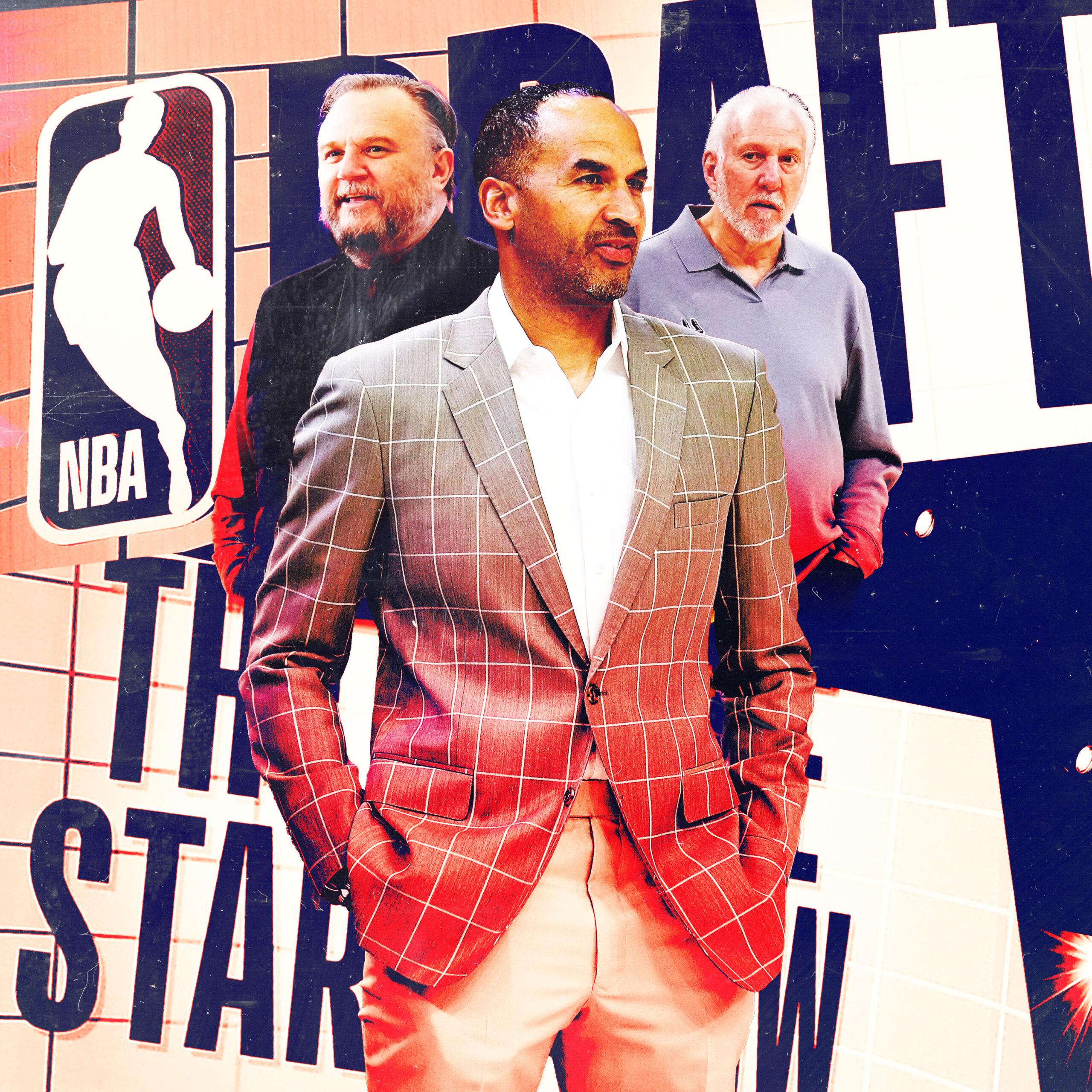
There’s a strange and reassuring rhythm to the NBA draft lottery. Strange, because the league blithely places the fates of multibillion-dollar franchises in a freakin’ ping-pong ball hopper. Reassuring, because we get to witness the predictable cascade of emotions as each team learns its draft position—from ho-hum acceptance (for the teams that stay put) to barely disguised despair (for those that slip) to respectful giddiness (for those who land in the top three).
Win the no. 1 pick, and you might get a blue-chip talent who revives your franchise. Win a top-three slot, and you might land a future perennial All-Star, or even an MVP. And so we got the requisite grins and giggles and fist pumps Monday night, as the beleaguered Dallas Mavericks leaped into the top slot despite just a 1.8 percent chance, with the San Antonio Spurs (second) and Philadelphia 76ers (third) landing just behind them.
Across the internet, the Photoshopping kicked into high gear: Cooper Flagg in a Mavs jersey; Dylan Harper in the silver and black; Ace Bailey in the red, white, and blue.
But across the league, a question started to percolate: What if one, two, or even (gasp) all three teams traded their picks this year? It’s never happened in the 78-year history of the NBA draft. To be sure, it probably won’t happen this time, either. But the striking uniqueness of this year’s draft order—and specifically, the situations the teams at the top are facing—make it at least plausible, and a question worth pondering.
“I can see it,” an NBA executive with a non-lottery team said after the lottery via text, when asked if all three teams could trade their picks. “It’s not crazy.”
Not crazy because by all rights none of the three teams should have been anywhere near the top of the draft order in the first place.
The Mavericks were in the Finals last season—albeit with a superstar they later traded away—and were still a viable playoff team until they lost star Kyrie Irving to a knee injury in early March. The Sixers, anchored by recent MVP Joel Embiid, were supposed to be a contender this season—albeit before their health and chemistry collapsed. And the Spurs, fortified by a midseason trade for All-Star De’Aaron Fox, were vying for a play-in berth before their young superstar—Victor Wembanyama, the first pick of the 2023 draft—was shut down because of a blood clot.
Not crazy, because these are not your typical lottery teams, and certainly not your typical one-two-three in the draft order. But the NBA’s flatter lottery odds, adopted in 2019, allowed these three well-stocked teams to make significant leaps in the draft order. Dallas was originally slotted 11th; San Antonio, eighth; and Philadelphia, fifth.
Not crazy because you could credibly and convincingly argue that all three teams need established, win-now veterans more than they need another teenage prospect. Even the best rookies rarely contribute to winning at a high level. (Wembanyama, the most talented prospect of the past 20 years, won 22 games in his rookie season. LeBron James won 35 in his first season.)
So, are we about to see a trading frenzy at the top of the 2025 board? “I would not be surprised if that happens,” said a second executive, also from a non-lottery team, “although I don’t think it will happen.”
Again: Not likely, but not crazy.
Let’s work backward from the third slot, where the Sixers—having transparently tanked the final weeks of the season by shutting down players—are surely both relieved and thrilled at their fortunes. Had the lottery balls bounced differently and dropped the Sixers below sixth, the pick would have been sent to the Oklahoma City Thunder, as final payment for a 2020 trade. Instead, the Sixers get the chance to add another high-level player to a roster that already features Embiid, Paul George, and Tyrese Maxey, plus last year’s promising rookie, Jared McCain.
If you squint (stay with me here), you can see the Sixers contending for the Eastern Conference crown next spring. The Cleveland Cavaliers just imploded in the second round of the playoffs. The Boston Celtics just lost Jayson Tatum to an Achilles rupture that will wipe out next season. The New York Knicks and Indiana Pacers are great, but not dominant. A healthy trio of Embiid (yes, I know), George, and Maxey, given a solid supporting cast, should win 50-plus games. The key variable, of course, is Embiid, who recently had his second knee surgery in a year.
If you assume that the 31-year-old Embiid, given injury history, will never be the same again, that the 35-year-old George is already cooked as an impact player, that this era is already a bust, then it makes sense to keep the no. 3 pick and add another young talent to form a post-Embiid core with Maxey and McCain. (They could even call it … the two-timeline plan!)
This is, in a sense, a moment of truth for the Sixers front office. Publicly, they confidently insist that Embiid will make a full recovery and dominate once again. If they privately have doubts, though, it makes sense to keep the pick and build for the future. But if they truly believe they’re still title contenders now, with Embiid as the centerpiece, then it’s hard to see how Bailey or V.J. Edgecombe or any other rookie will help their cause.
The Sixers could either trade the third pick outright for an established player or perhaps trade down in the order and pick up more rotation pieces in the swap. Or, as one rival exec suggested, the Sixers could flip the pick for a collection of future picks.
The calculus for the Spurs at no. 2 is a little more complicated. They already have their North Star in Wembanyama, an established All-Star in Fox, and a budding star in Stephon Castle, who just won Rookie of the Year. They’re already primed to make a run at the playoffs next season. And they’re already well stocked in the backcourt, which would make Harper—the presumed second pick in the draft—a little superfluous. The Spurs could trade down, to draft for a position of need while picking up more assets, or they could trade the pick entirely for established players.
The question for the Spurs is: How methodical do they want to be in building around Wemby? Or, to put it another way: How soon do they want to become a title contender? Is it time to hit the accelerator?
The Spurs also have a healthy cache of draft picks, which puts them in prime position to make a blockbuster trade. Should they go all out to pursue Giannis Antetokounmpo? Would they consider a short-term bet on Kevin Durant’s twilight years? Could they pry loose Devin Booker? And should they dangle that no. 2 pick to get a deal done? Or are they content to let the young core keep evolving, and add Harper to it?
The Mavericks have the opposite quandary, with two oft-injured stars in their late prime (Irving at 33, Anthony Davis at 32) and a quickly shrinking window to contend for a championship—and to vindicate team president Nico Harrison’s shocking decision to trade Luka Doncic for Davis in February.
At the time of the deal, Harrison said Davis “fits our time frame,” which he described as “three, four years.” But it will almost certainly be shorter given his stars’ age, which means the Mavs’ urgency is through the stratosphere. Flagg, 18, is viewed by scouts as a terrific talent, skilled and intuitive, a capable defender and primed to make an impact on day one. But stardom is hardly guaranteed, and experts differ on how high his ceiling will be.
One team executive says Flagg has “superstar” potential but stopped short of calling him a future MVP candidate. Another said Flagg has a high chance of becoming an All-Star but is not in the same tier as recent no. 1 picks like Wembanyama and Zion Williamson, who were considered can’t-miss generational prospects. A third exec mused that Flagg might top out as a “very good” player “but not a star.”
Flagg’s NBA comps, according to our own J. Kyle Mann, range from Nicolas Batum to Andrei Kirilenko to Shawn Marion to Scottie Pippen.
Are the Mavericks—who won their 2011 title with Marion in the lineup—one Matrix sequel away from a championship? Is Flagg their missing piece? Or, in the best-case scenario, their new Dirk Nowitzki? Their new, er, Luka? Or is he just Nic Batum-point-oh? (Sorry.)
Given the uncertainty, might it make more sense to swap the pick (and other assets) to Milwaukee, for Antetokounmpo? If the Mavs’ window is really just two to three years, wouldn’t they be better off with a 30-year-old, two-time MVP than a teenaged neophyte? (There would be some amusing symmetry here: Twenty-seven years ago, the Bucks and Mavericks made a draft-night trade involving the no. 9 pick. Tall guy. From Germany. Sweet jumper. You’ve probably heard of him.)
Or, if Giannis is unattainable, could Dallas trade Flagg’s draft rights for a second-tier star? One exec suggested a Trae Young/Ja Morant/Lauri Markkanen–level player.
Then again, given the unprecedented backlash to the Doncic trade, and fans’ sheer elation at winning the top pick, would Harrison dare trade the rights to such a promising and popular player? “I would expect anything and everything from Nico,” the same exec said.
Trades involving the no. 1 pick are exceedingly rare, of course. There have been only five since the ABA-NBA merger: Markelle Fultz in 2017 (from Boston to Philadelphia), Andrew Wiggins in 2014 (from Cleveland to Minnesota), Chris Webber in 1993 (from Orlando to Golden State), Brad Daugherty in 1986 (from Philadelphia to Cleveland), and Joe Barry Carroll in 1980 (from Boston to Golden State).
In fact, trades involving any of the top-three picks are rare. All told, 11 have changed hands since 2000—but only four were traded on or around draft day. The other seven were traded months or even years before, as part of other deals.
And of course, everyone’s being cagey in the wake of this week’s lottery. The Sixers intend to keep the no. 3 pick, according to a team source. The Mavericks “will not entertain the possibility” of trading the no. 1 pick, ESPN reported. And the Spurs? They are reportedly “open-minded” about dealing the no. 2 pick, per ESPN.
Of course, no one’s going to tip their hands at this stage. No team with a top-three pick ever declares a public bidding war. And team officials, believe it or not, do not always tell the truth about their intentions. So forget the denials and the dissembling. Anything is possible. We could indeed see a top pick traded. Or two. Or three.
Crazy? Perhaps. But these are wild times in the NBA. Anything’s possible, even on draft night. Let’s go crazy.

